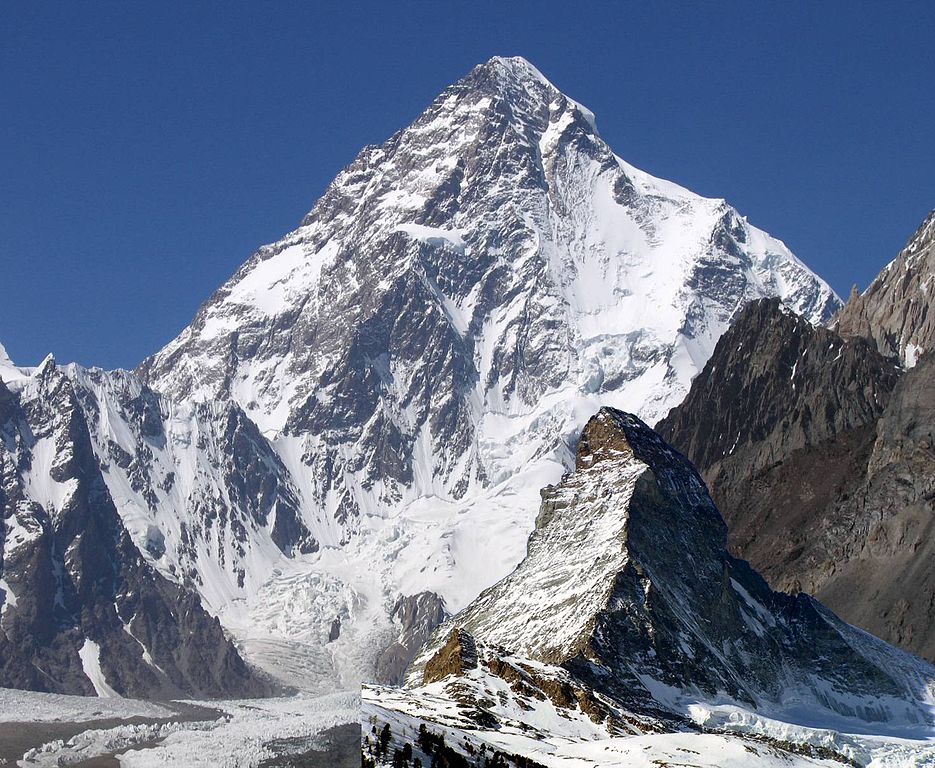"K2 just has something about it. Partly it's the shape and beauty and symmetry of the thing. And partly it's the infamy"
IF THE CRITERION YOU USE to measure the majesty of mountains is simple math, then the greatest peak on earth is Everest; at 29,035 feet, it surpasses K2 by 785 feet. If popularity is the gauge, the answer seems equally obvious: More than 1,600 people have been to the top of Everest, claiming all manner of "firsts," including but by no means limited to: the first one-legged summiter, the first one-armed summiter, the first person to sleep on the summit, the first live TV broadcast from the summit, the first person to make five summits in five consecutive years, and the first husband-and-wife team to fling themselves off the summit in a tandem paraglider. This year, another 262 climbers have reached the highest point on the planet as of press time. And in 2008, the Chinese intend to carry the Olympic torch to the top on their way to Beijing.

It was the second summitless year in a row, a statistic that, at least by the standards of Everest-level success, seemed to confirm K2's stature as the lesser giant. But among professional mountaineers who tackle the world's most formidable peaks, things look a bit different.
"People are drawn to Everest because everyone can understand the idea of 'the highest mountain on earth,'" says Greg Child, an Australian mountaineer and author who has summited both Everest and K2. "Christ, my grandmother can understand that. Unless you're on the inside of climbing, however, it's almost impossible to fathom an obsession with the second-highest. But K2 just has something about it. Partly it's the shape and beauty and symmetry of the thing. And partly it's the infamy — the stories of what's happened to people who've tried it: how fucked up they've become and how many have died. K2 is simply not an amateur's mountain."
K2's difficulties begin with its remoteness, reflected by the fact that the Balti hill people don't even have a name for the mountain. It was dubbed K2 — K for Karakoram and 2 for the second peak in the range to be identified — by the British mapmaker T.G. Montgomerie in 1856. "Just the bare bones of a name," wrote the Italian alpinist Fosco Maraini in his 1959 book Karakoram: The Ascent of Gasherbrum IV. "All rock and ice and storm and abyss. It makes no attempt to sound human."
"K2 is simply not an amateur's mountain."
K2's remoteness has other consequences. It sits eight degrees north of Everest, so the weather is considerably more vicious. "It's much colder, and great storms come shrieking off the mountain," says British mountaineer Jim Curran, author of K2: The Story of the Savage Mountain, the definitive history of the peak. "Unlike Everest, you almost never get a good, clean week to push for the summit."
Everest also boasts a well-established support infrastructure of guides and Sherpas who set up tents, fix ropes, and ferry canisters of supplemental oxygen to the high camps. On K2, there are few high-altitude porters or commercial firms — partly because of the isolation and partly because experience has demonstrated that guiding a mountain like K2 is an invitation to disaster. This point was proven yet again this July when a German climber named Klaus-Dieter Grohs slipped and fell to his death while pushing to the top. One of ten clients being led up the mountain by Kari Kobler, a veteran Swiss Himalayan guide who has climbed Everest twice, Grohs became the 53rd person to die on K2.
According to a 2000 study on high-altitude mountaineering deaths published in The American Alpine Journal, one in 29 climbers who summited Everest between 1978 and 1999 died on descent; on K2, one summiter in seven perished. "Those are pretty grim odds," says Raymond Huey, a professor of biology at the University of Washington who co-authored the study. "It's getting perilously close to Russian roulette." Things become even more dire when you compare summit fatalities among climbers who did not use supplemental oxygen: On Everest, the casualty rate is one in 12; on K2, it's nearly one in five.
That last number is rather chilling: Even among experienced mountaineers, K2 is more than twice as deadly as Everest. "Think of it this way," suggests Curran. "From Everest Base Camp, you can walk four hours and you're lounging on grass, drinking beer with trekkers. K2 stands absolutely on its own. The approach is hard. The base camp feels like the moon. The mountain itself looks utterly impregnable, and there's no easy way up the thing. And all this hits you between the eyes when you see it for the first time. It's like that famous Munch painting. You know the one - The Scream? Except, of course, you're the one doing the screaming."
